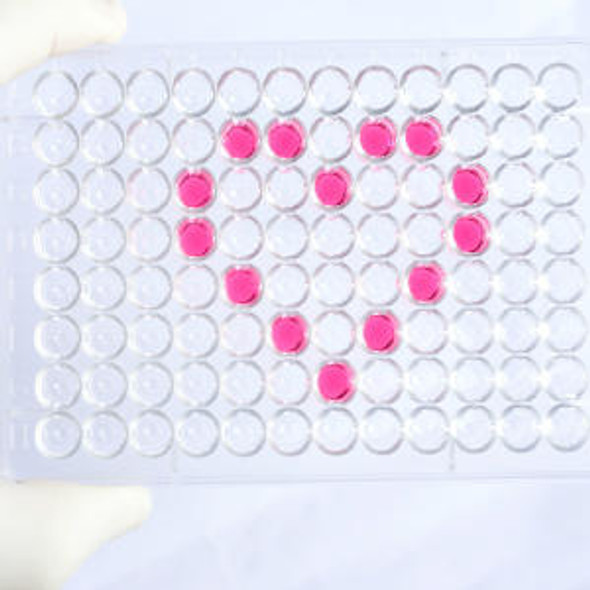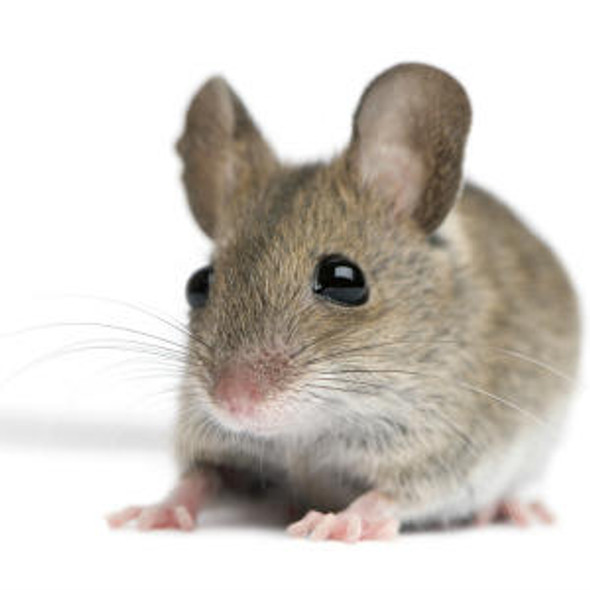Human Cell Biology ELISA Kits 5
Human PF4 (Platelet Factor 4) CLIA Kit (HUES01165)
- SKU:
- HUES01165
- Product Type:
- ELISA Kit
- ELISA Type:
- CLIA Kit
- Size:
- 96 Assays
- Sensitivity:
- 0.19ng/mL
- Range:
- 0.31-20ng/mL
- ELISA Type:
- Sandwich
- Reactivity:
- Human
- Sample Type:
- Serum, plasma and other biological fluids
- Research Area:
- Cell Biology
Description
| Assay type: | Sandwich |
| Format: | 96T |
| Assay time: | 4.5h |
| Reactivity: | Human |
| Detection method: | Chemiluminescence |
| Detection range: | 0.31-20 ng/mL |
| Sensitivity: | 0.19 ng/mL |
| Sample volume: | 100µL |
| Sample type: | Serum, plasma and other biological fluids |
| Repeatability: | CV < 15% |
| Specificity: | This kit recognizes Human PF4 in samples. No significant cross-reactivity or interference between Human PF4 and analogues was observed. |
This kit uses Sandwich-CLIA as the method. The micro CLIA plate provided in this kit has been pre-coated with an antibody specific to Human PF4. Standards or samples are added to the appropriate micro CLIA plate wells and combined with the specific antibody. Then a biotinylated detection antibody specific for Human PF4 and Avidin-Horseradish Peroxidase (HRP) conjugate are added to each micro plate well successively and incubated. Free components are washed away. The substrate solution is added to each well. Only those wells that contain Human PF4, biotinylated detection antibody and Avidin-HRP conjugate will appear fluorescence. The Relative light unit (RLU) value is measured spectrophotometrically by the Chemiluminescence immunoassay analyzer. The RLU value is positively associated with the concentration of Human PF4. The concentration of Human PF4 in the samples can be calculated by comparing the RLU of the samples to the standard curve.
| UniProt Protein Function: | PF4: Released during platelet aggregation. Neutralizes the anticoagulant effect of heparin because it binds more strongly to heparin than to the chondroitin-4-sulfate chains of the carrier molecule. Chemotactic for neutrophils and monocytes. Inhibits endothelial cell proliferation, the short form is a more potent inhibitor than the longer form. Belongs to the intercrine alpha (chemokine CxC) family. |
| UniProt Protein Details: | Protein type:Motility/polarity/chemotaxis; Apoptosis; Secreted, signal peptide; Chemokine; Secreted Chromosomal Location of Human Ortholog: 4q12-q21 Cellular Component: extracellular space; extracellular region Molecular Function:heparin binding; CXCR3 chemokine receptor binding; chemokine activity Biological Process: negative regulation of cytolysis; platelet activation; leukocyte chemotaxis; cytokine and chemokine mediated signaling pathway; positive regulation of leukocyte chemotaxis; response to lipopolysaccharide; positive regulation of cAMP metabolic process; positive regulation of tumor necrosis factor production; negative regulation of megakaryocyte differentiation; regulation of cell proliferation; G-protein coupled receptor protein signaling pathway; negative regulation of angiogenesis; platelet degranulation; negative regulation of MHC class II biosynthetic process; positive regulation of transcription from RNA polymerase II promoter; immune response; positive regulation of macrophage differentiation; inflammatory response; blood coagulation |
| NCBI Summary: | This gene encodes a member of the CXC chemokine family. This chemokine is released from the alpha granules of activated platelets in the form of a homotetramer which has high affinity for heparin and is involved in platelet aggregation. This protein is chemotactic for numerous other cell type and also functions as an inhibitor of hematopoiesis, angiogenesis and T-cell function. [provided by RefSeq, Mar 2012] |
| UniProt Code: | P02776 |
| NCBI GenInfo Identifier: | 130304 |
| NCBI Gene ID: | 5196 |
| NCBI Accession: | P02776. 2 |
| UniProt Secondary Accession: | P02776,Q53X61, Q9UC64, Q9UC65, |
| UniProt Related Accession: | P02776 |
| Molecular Weight: | 10,845 Da |
| NCBI Full Name: | Platelet factor 4 |
| NCBI Synonym Full Names: | platelet factor 4 |
| NCBI Official Symbol: | PF4 |
| NCBI Official Synonym Symbols: | PF-4; CXCL4; SCYB4 |
| NCBI Protein Information: | platelet factor 4; iroplact; oncostatin-A; C-X-C motif chemokine 4; chemokine (C-X-C motif) ligand 4 |
| UniProt Protein Name: | Platelet factor 4 |
| UniProt Synonym Protein Names: | C-X-C motif chemokine 4; Iroplact; Oncostatin-ACleaved into the following chain:Platelet factor 4, short form |
| Protein Family: | Platelet factor |
| UniProt Gene Name: | PF4 |
| UniProt Entry Name: | PLF4_HUMAN |
As the RLU values of the standard curve may vary according to the conditions of the actual assay performance (e. g. operator, pipetting technique, washing technique or temperature effects), the operator should establish a standard curve for each test. Typical standard curve and data is provided below for reference only.
| Concentration (ng/mL) | RLU | Average | Corrected |
| 20 | 32435 35529 | 33982 | 33950 |
| 10 | 11947 12993 | 12470 | 12438 |
| 5 | 5260 5240 | 5250 | 5218 |
| 2.5 | 2450 2598 | 2524 | 2492 |
| 1.25 | 1458 1308 | 1383 | 1351 |
| 0.63 | 914 820 | 867 | 835 |
| 0.31 | 620 626 | 623 | 591 |
| 0 | 31 33 | 32 | -- |
Precision
Intra-assay Precision (Precision within an assay): 3 samples with low, mid range and high level Human PF4 were tested 20 times on one plate, respectively.
Inter-assay Precision (Precision between assays): 3 samples with low, mid range and high level Human PF4 were tested on 3 different plates, 20 replicates in each plate.
| Intra-assay Precision | Inter-assay Precision | |||||
| Sample | 1 | 2 | 3 | 1 | 2 | 3 |
| n | 20 | 20 | 20 | 20 | 20 | 20 |
| Mean (ng/mL) | 0.93 | 2.17 | 8.85 | 0.90 | 2.17 | 8.10 |
| Standard deviation | 0.09 | 0.18 | 0.78 | 0.09 | 0.17 | 0.69 |
| C V (%) | 9.68 | 8.29 | 8.81 | 10.00 | 7.83 | 8.52 |
Recovery
The recovery of Human PF4 spiked at three different levels in samples throughout the range of the assay was evaluated in various matrices.
| Sample Type | Range (%) | Average Recovery (%) |
| Serum (n=5) | 100-116 | 106 |
| EDTA plasma (n=5) | 98-116 | 106 |
| Cell culture media (n=5) | 88-102 | 95 |
Linearity
Samples were spiked with high concentrations of Human PF4 and diluted with Reference Standard & Sample Diluent to produce samples with values within the range of the assay.
| Serum (n=5) | EDTA plasma (n=5) | Cell culture media (n=5) | ||
| 1:2 | Range (%) | 88-102 | 93-110 | 100-117 |
| Average (%) | 95 | 100 | 107 | |
| 1:4 | Range (%) | 94-108 | 103-116 | 87-99 |
| Average (%) | 101 | 110 | 93 | |
| 1:8 | Range (%) | 104-119 | 92-106 | 88-101 |
| Average (%) | 110 | 98 | 95 | |
| 1:16 | Range (%) | 96-111 | 87-99 | 102-114 |
| Average (%) | 103 | 93 | 108 |
An unopened kit can be stored at 4°C for 1 month. If the kit is not used within 1 month, store the items separately according to the following conditions once the kit is received.
| Item | Specifications | Storage |
| Micro CLIA Plate(Dismountable) | 8 wells ×12 strips | -20°C, 6 months |
| Reference Standard | 2 vials | |
| Concentrated Biotinylated Detection Ab (100×) | 1 vial, 120 µL | |
| Concentrated HRP Conjugate (100×) | 1 vial, 120 µL | -20°C(shading light), 6 months |
| Reference Standard & Sample Diluent | 1 vial, 20 mL | 4°C, 6 months |
| Biotinylated Detection Ab Diluent | 1 vial, 14 mL | |
| HRP Conjugate Diluent | 1 vial, 14 mL | |
| Concentrated Wash Buffer (25×) | 1 vial, 30 mL | |
| Substrate Reagent A | 1 vial, 5 mL | 4°C (shading light) |
| Substrate Reagent B | 1 vial, 5 mL | 4°C (shading light) |
| Plate Sealer | 5 pieces | |
| Product Description | 1 copy | |
| Certificate of Analysis | 1 copy |
- Set standard, test sample and control (zero) wells on the pre-coated plate and record theirpositions. It is recommended to measure each standard and sample in duplicate. Note: addall solutions to the bottom of the plate wells while avoiding contact with the well walls. Ensuresolutions do not foam when adding to the wells.
- Aliquot 100 µL of standard solutions into the standard wells.
- Add 100 µL of Sample / Standard dilution buffer into the control (zero) well.
- Add 100 µL of properly diluted sample (serum, plasma, tissue homogenates and otherbiological fluids. ) into test sample wells.
- Cover the plate with the sealer provided in the kit and incubate for 90 min at 37 °C.
- Aspirate the liquid from each well, do not wash. Immediately add 100 µL of BiotinylatedDetection Ab working solution to each well. Cover the plate with a plate seal and gently mix. Incubate for 1 hour at 37 °C.
- Aspirate or decant the solution from the plate and add 350 µL of wash buffer to each welland incubate for 1-2 minutes at room temperature. Aspirate the solution from each well andclap the plate on absorbent filter paper to dry. Repeat this process 3 times. Note: a microplatewasher can be used in this step and other wash steps.
- Add 100 µL of HRP Conjugate working solution to each well. Cover with a plate seal andincubate for 30 min at 37 °C.
- Aspirate or decant the solution from each well. Repeat the wash process for five times asconducted in step 7.
- Add 100 µL of Substrate mixture solution to each well. Cover with a new plate seal andincubate for no more than 5 min at 37 °C. Protect the plate from light.
- Determine the RLU value of each well immediately.






